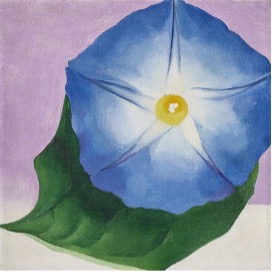O’Keeffe’s art is currently having a moment. Not Georgia O’Keeffe’s – that’s as popular as it’s ever been. No, I’m talking about the art of her little sister, Ida Ten Eyck O’Keeffe (1889-1961), which scored a huge success at Christie’s last week.
Born in Sun Prairie, Wisconsin, Ida studied art with the same teacher as her older sister and a younger sister, Anita, in Williamsburg, Virginia, where the family had moved when she was 13. The sisters’ family was artistic – both grandmothers had been artists, and yet another sister, Catherine, was also a painter – but family finances were often precarious, and the girls learned early that they would have to make their own ways in the world. Both Georgia and Ida became public school art teachers, but Ida later became a nurse. Ida continued her art studies, however, eventually receiving her MFA from Columbia University in 1932.
While living in New York, Ida was in close contact with her older sister and with Georgia’s husband, the noted art dealer Alfred Stieglitz, but sibling rivalry often made things uncomfortable. Georgia’s biographer, Laurie Lisle, noted in a 1980 book that Ida “got the emphatic message that Georgia wanted to be the only O’Keeffe who painted.” Georgia forbade Stieglitz from ever exhibiting her sister’s work. “I’d be famous, too, if I’d had a Stieglitz,” Ida later groused. In her first New York exhibition, she listed herself as Ida Ten Eyck. That may have been as much a matter of Ida’s not wanting to be compared to her sister as of Georgia’s sharp elbows.
At any rate, Ida left New York in the 1930’s and spent her life working as an art teacher or as a nurse. Her day jobs kept her artistic output relatively small – around 70 of her canvases are known, in contrast to Georgia’s 2000. For the last 30 years of Ida’s life, the sisters were estranged. Ida died in Whittier, California, in 1961, 25 years before her older sister. In 2019 the Dallas Museum of Art mounted a traveling exhibition of her work, but there’s no escaping that last name, and the show was titled, “Ida O’Keeffe: Escaping Georgia’s Shadow.”
Ida’s relative obscurity was heightened by the fact that all of her best works had been sold privately by galleries. Nothing of real importance had appeared at auction until last week. A painting of a tree sold at auction for a record $19,000 hammer five months ago. Christie’s clearly had that result in mind when they placed an estimate of $25,000-35,000 for “Flowers” in last week’s sale.

Ida O’Keeffe, “Flowers (Gardenias in a Pitcher)” 1932
Oil on canvas, 8 x 7 inches
Photo courtesy Christie’s New York

Georgia O’Keeffe, “Blue Morning Glory” 1934
Oil on canvas, 7 x 7 inches
Photo courtesy Christie’s New York
The small but classic painting blew past its estimate to sell for $302,400 including premium. As they say in the art business, one high auction price is a record, two prices are a trend, but it takes three such auction prices to make a market. Does this herald an era of six-figure auction prices for Ida’s paintings from here on out? I doubt it. There just isn’t enough “product.” As I’ve said, Ida’s output was relatively scanty, and most of the best works from the late 1920’s – early 1930’s are in private collections. Unless their owners put those works up for auction, there will be no public results that even approach last week’s.
If there’s a heaven for artists (and I’m of the firm belief that most artists head the other direction), Ida isn’t shoving this auction result in her sister’s face, as Georgia would smugly point to the result achieved at the same Christie’s sale by her own painting, roughly the same size as Ida’s, which sold for $1,744,000 including premium.
Two paintings of flowers, each about half the size of a sheet of typing paper, done within two years of each other by two artists named O’Keeffe, sold for much different results. Perhaps Ida should bask in last week’s result and then remind herself of the Buddhist maxim, “To compare is to suffer.”

